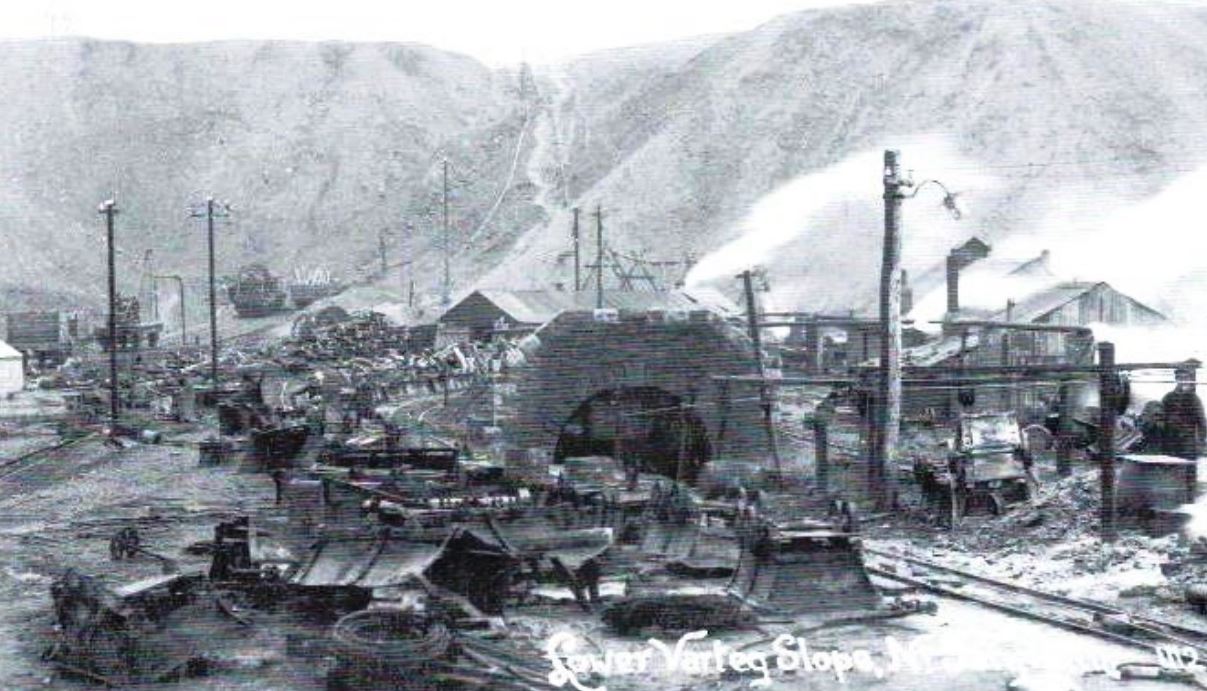 Also known as Lower Varteg Colliery
Also known as Lower Varteg Colliery
Near Garndiffaith, Afan Lwyd Valley (255053)
The main haulage road for this mine was started in 1899 and drifted down 1 in 10 to the Bottom Vein Mine (ironstone) then it inclined upwards 1 in 70 through the Old Coal seam to the Meadow Vein seam. It then continued on the Meadow Vein seam level to the Varteg Hill Pits which became the upcast ventilation shaft for this colliery.
A 160 hp surface haulage was installed to bring the coal out at a maximum rate of 500 tons per shift. It was in production by 1901 and owned by the Varteg Deep Black Vein Collieries Limited, which was a member of the Monmouthshire and South Wales Coal Owners Association. At the start of its life, it was called Varteg Deep or Lower Varteg.
It was bounded to the west by geological faulty ground and on all other sides by waterlogged old workings. It employed 403 men in 1913 and was still owned by the Varteg Company in 1917, and employed 451 men underground and 102 men on the surface in 1918 when the manager was A.K. Edmunds. By 1921 this company had become John Vipond & Co., which was based at the Varteg Hill Colliery. The chairman of this company was T.H. Deakin. John Vipond was born in Cheshire in 1800 and came to South Wales to cash in on the coal boom. He sunk the Varteg Pits in 1860 but also died that year. His name lived on with the company title until Nationalisation in 1947. This company was also a member of the Monmouthshire and South Wales Coal Owners Association.
By 1935 Deakins’ Slope had been merged with the No.10 Slope and together they employed 64 men on the surface and 451 men underground producing gas, manufacturing, house and steam coals. The manager was J.R. Jones. In 1938 there were 312 men working underground and 60 men on the surface with the manager being H.D. Connick. Mr. Connick was still manager in 1943/5 when the mine employed 448 men underground working the Garw, Big, Lower Three-quarter and Old Coal seams and 111 men on the surface.
On Nationalisation in 1947 this colliery was placed in the National Coal Board’s, South Western Division’s, No.6 (Monmouthshire) Area, and at that time employed 140 men on the surface and 409 men underground working the Garw, Four-Feet, Yard, Seven-Feet and Two-Feet-Nine seams. The manager at that time was still H.D. Connick who was still there in 1949. In 1956 out of a total manpower of 177 men at this colliery, 60 of them worked at the coalfaces. By 1956 all the workable reserves for this colliery had been extracted and on the 10th of June 1956, authority was given for closure. Production ceased on the 26th of January 1957 and closure was completed by the 23rd of May 1959.
The men were transferred as follows:
- Big Pit 181 men
- Blaenserchan 65 men
- Red Ash 14 men
- Leavers 19 men
- Glyntillery 2 men
- Tirpentwys 30 men
- Hafodyrynys 2 men
Some Statistics:
- 1913: Manpower: 403.
- 1923: Manpower: 533.
- 1924: Manpower: 541.
- 1928: Manpower: 533.
- 1930: Manpower: 598.
- 1933: Manpower: 488.
- 1934: Manpower: 503.
- 1935: Manpower: 515.
- 1937: Manpower: 443.
- 1938: Manpower: 372.
- 1943: Manpower: 559.
- 1945: Manpower: 559.
- 1947: Manpower: 549.
- 1949: Manpower: 418. Output: 116,000 tons.
- 1950: Manpower: 418.
- 1953: Manpower: 315. Output: 104,000 tons.
- 1954: Output: 79,000 tons.
- 1955: Manpower: 317. Output: 88,579 tons.
- 1956: Manpower: 177. Output: 85,591 tons.
See also the Varteg Hill Mines that were merged with Deakins Slope by the National Coal Board on Nationalisation in 1947
LOWER VARTEG COLLIERY (Deakins Slope) – Not sure why there is a separate entry for this
Varteg, Afan Lwyd Valley (252051)
This mine employed 305 men in 1899 when owned by Jayne and Deakin, and was owned in 1900/2 by the Lower Varteg Colliery Company (Jayne & Deakin) and worked for steam coals employing 373 men underground and 38 men at the surface in 1900 with the manager being T. Smith.
In 1901 the company name became the Varteg Deep Black Vein Collieries Limited who employed 374 men here in 1907 and 357 men underground and 38 men on the surface with the manager being A.K. Edmonds in 1908. It was working the Rock, Yard, Meadow Vein and Old Coal seams. In 1910 it employed 452 men, in 1911 it employed
470 men and in 1912 it employed 414 men. In 1913 along with the No.10 Slope employed 403 men still being managed by A.K. Edmonds. In 1915/6 it employed 400 men and in 1919 it employed 460 men and was still managed by A. Edmonds. In 1927 there was only the No.10 Slope and it employed 460 men. By 1932 it was owned by Powell’s Tillery Collieries Limited and employed 462 men. It was not listed as such in 1935 but see Deakins Slope.
Some of those that died at this mine:
- 14/12/1899, Morgan Edwards, Age: 70: Doorkeeper: run over by trams.
- 20/02/1915, Baden Higgs: Collier: Fall of a large stone.
- 13/03/1918, Leonard Bishop: Collier: Roof fall.
- 26/11/1919, John Watkins: Collier: Struck on the head by a stone.
- 13/04/1922, John Clark: Roof fall.
- 20/06/1923, Albert Hopkins: Trucks out of control and crushed him.
- 18/03/1925, Ernest Carter: Drawn into machinery.
- 09/07/1927, John Meeks: Struck by a journey of trams.
- 23/09/1929, William Silcock, Age: 58: Collier: He was shackling trams when he slipped and his head was crushed between trams.
- 7/11/1929, William Henry Morgan, Age: 17: Assistant Collier: Fall of stone.
Information supplied by Ray Lawrence and used here with his permission.
Return to previous page
